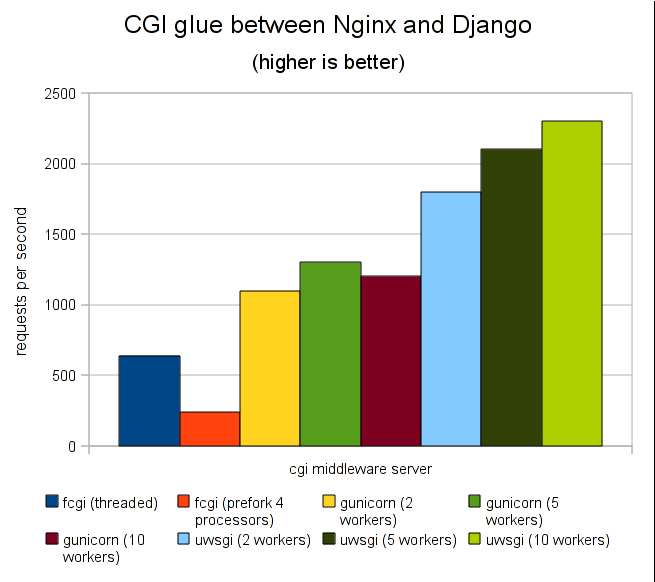如何在生產上部署Django?
Django的部署可以有很多方式,采用nginx+uwsgi的方式是其中比較常見的一種方式。
uwsgi介紹
uWSGI是一個Web服務器,它實現了WSGI協議、uwsgi、http等協議。Nginx中HttpUwsgiModule的作用是與uWSGI服務器進行交換。
要注意 WSGI / uwsgi / uWSGI 這三個概念的區分。
- WSGI是一種Web服務器網關接口。它是一個Web服務器(如nginx,uWSGI等服務器)與web應用(如用Flask框架寫的程序)通信的一種規范。
- uwsgi是一種線路協議而不是通信協議,在此常用于在uWSGI服務器與其他網絡服務器的數據通信。
- 而uWSGI是實現了uwsgi和WSGI兩種協議的Web服務器。
- uwsgi協議是一個uWSGI服務器自有的協議,它用于定義傳輸信息的類型(type of information),每一個uwsgi packet前4byte為傳輸信息類型描述,它與WSGI相比是兩樣東西。
uwsgi性能非常高

uWSGI的主要特點如下
- 超快的性能
- 低內存占用(實測為apache2的mod_wsgi的一半左右)
- 多app管理(終于不用冥思苦想下個app用哪個端口比較好了-.-)
- 詳盡的日志功能(可以用來分析app性能和瓶頸)
- 高度可定制(內存大小限制,服務一定次數后重啟等)
總而言之uwgi是個部署用的好東東,正如uWSGI作者所吹噓的:
If you are searching for a simple wsgi-only server, uWSGI is not for you, but if you are building a real (production-ready) app that need to be rock-solid, fast and easy to distribute/optimize for various load-average, you will pathetically and morbidly fall in love (we hope) with uWSGI.
Uwsgi 安裝使用
# Install the latest stable release:
pip install uwsgi
# ... or if you want to install the latest LTS (long term support) release,
pip install https://projects.unbit.it/downloads/uwsgi-lts.tar.gz
基本測試
Create a file called test.py:
|
1
2
3
4
5
|
# test.pydef application(env, start_response): start_response('200 OK', [('Content-Type','text/html')]) return [b"Hello World"] # python3 #return ["Hello World"] # python2 |
運行
uwsgi --http :8000 --wsgi-file test.py
用uwsgi 啟動django
uwsgi --http :8000 --module mysite.wsgi
可以把參數寫到配置文件里
|
1
2
3
4
5
6
7
8
9
10
11
12
13
14
15
16
17
18
19
20
|
alex@alex-ubuntu:~/uwsgi-test$ more crazye-uwsgi.ini [uwsgi]http = :9000#the local unix socket file than commnuincate to Nginxsocket = 127.0.0.1:8001# the base directory (full path)chdir = /home/alex/CrazyEye# Django's wsgi filewsgi-file = CrazyEye/wsgi.py# maximum number of worker processesprocesses = 4#thread numbers startched in each worker processthreads = 2 #monitor uwsgi statusstats = 127.0.0.1:9191# clear environment on exitvacuum = true |
啟動
/usr/local/bin/uwsgi crazye-uwsgi.ini
Nginx安裝使用
sudo apt-get install nginx
sudo /etc/init.d/nginx start # start nginx
為你的項目生成Nginx配置文件
You will need the uwsgi_params file, which is available in the nginx directory of the uWSGI distribution, or from https://github.com/nginx/nginx/blob/master/conf/uwsgi_params
Copy it into your project directory. In a moment we will tell nginx to refer to it.
Now create a file called mysite_nginx.conf, and put this in it:
|
1
2
3
4
5
6
7
8
9
10
11
12
13
14
15
16
17
18
19
20
21
22
23
24
25
26
27
28
29
30
31
32
33
34
|
# mysite_nginx.conf # the upstream component nginx needs to connect toupstream django { # server unix:///path/to/your/mysite/mysite.sock; # for a file socket server 127.0.0.1:8001; # for a web port socket (we'll use this first)} # configuration of the serverserver { # the port your site will be served on listen 8000; # the domain name it will serve for server_name .example.com; # substitute your machine's IP address or FQDN charset utf-8; # max upload size client_max_body_size 75M; # adjust to taste # Django media location /media { alias /path/to/your/mysite/media; # your Django project's media files - amend as required } location /static { alias /path/to/your/mysite/static; # your Django project's static files - amend as required } # Finally, send all non-media requests to the Django server. location / { uwsgi_pass django; include /path/to/your/mysite/uwsgi_params; # the uwsgi_params file you installed }} |
This conf file tells nginx to serve up media and static files from the filesystem, as well as handle requests that require Django's intervention. For a large deployment it is considered good practice to let one server handle static/media files, and another handle Django applications, but for now, this will do just fine.
Symlink to this file from /etc/nginx/sites-enabled so nginx can see it:
sudo ln -s ~/path/to/your/mysite/mysite_nginx.conf /etc/nginx/sites-enabled/
Deploying static files
Before running nginx, you have to collect all Django static files in the static folder. First of all you have to edit mysite/settings.py adding:
STATIC_ROOT = os.path.join(BASE_DIR, "static/")
and then run
python manage.py collectstatic
此時啟動Nginx 和Uwsgi,你的django項目就可以實現高并發啦!
以上就是本文的全部內容,希望對大家的學習有所幫助,也希望大家多多支持服務器之家。
原文鏈接:https://www.cnblogs.com/alex3714/p/6538374.html










